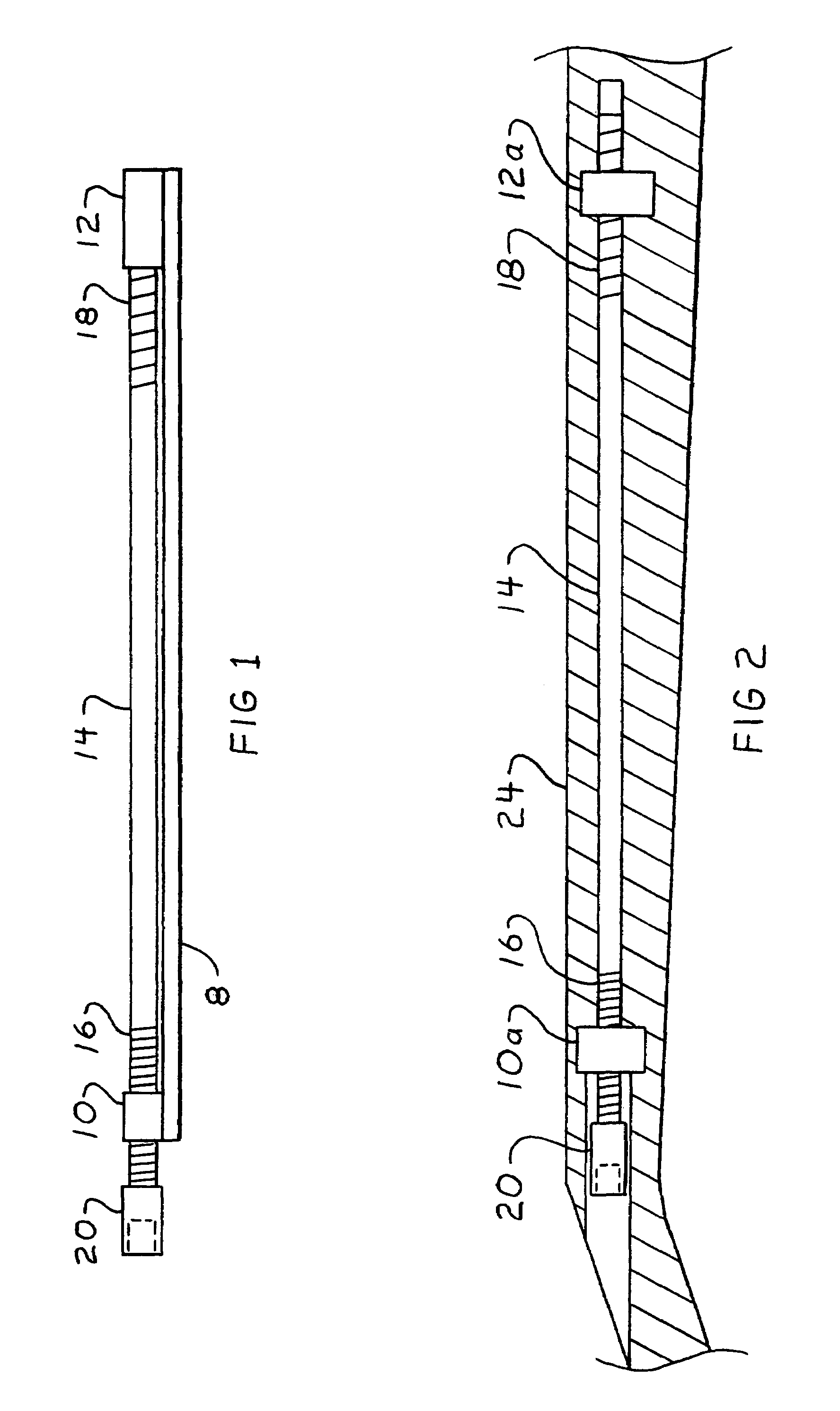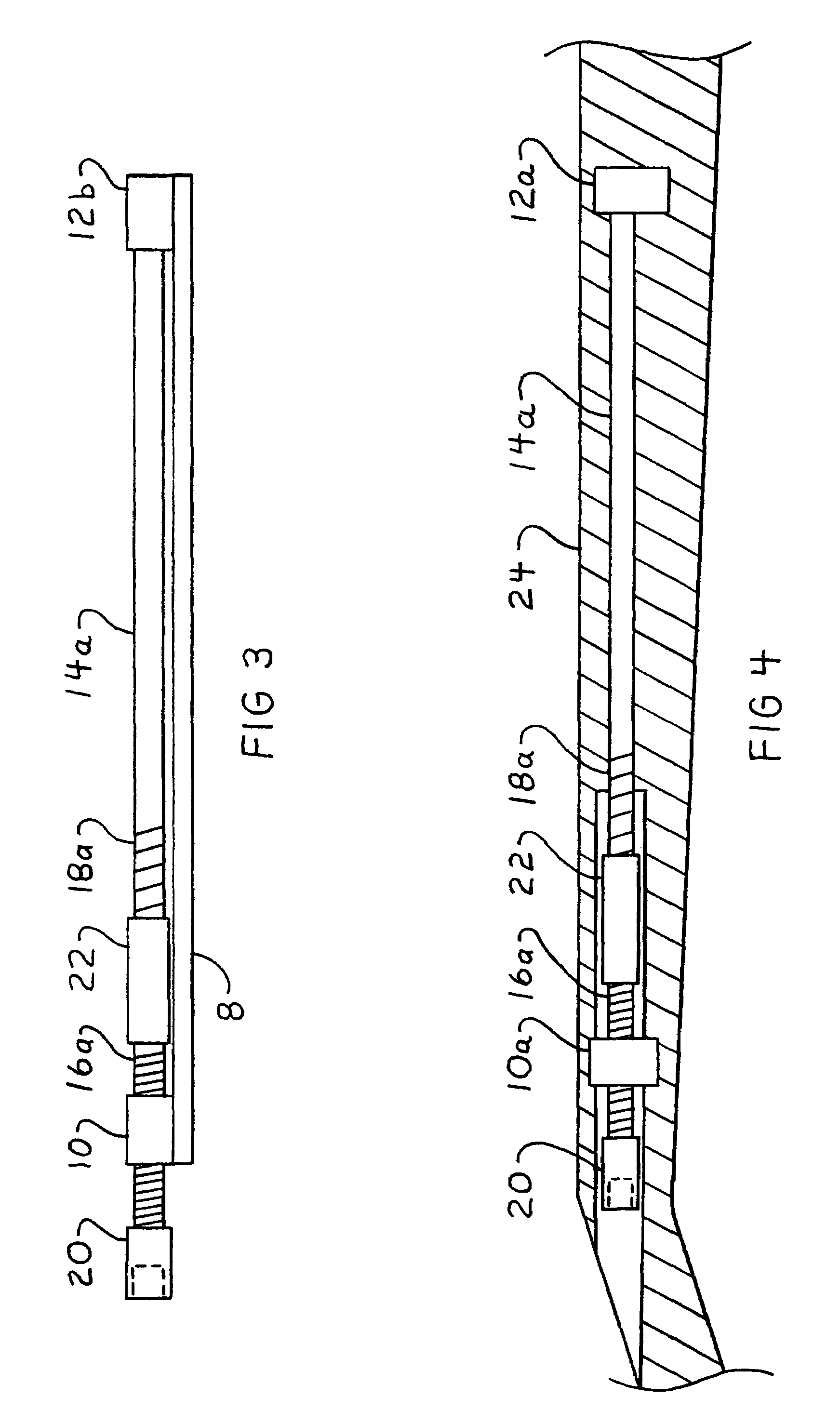Precision double acting truss for stringed musical instruments
a double-adjustable, musical instrument technology, applied in the direction of stringed musical instruments, instruments, musical instruments, etc., can solve the problems of truss rod that requires undue amounts of force to adjust, difficult to precisely adjust, and inability to provide the right amount of neck curvatur
- Summary
- Abstract
- Description
- Claims
- Application Information
AI Technical Summary
Benefits of technology
Problems solved by technology
Method used
Image
Examples
first embodiment
, FIG. 1
[0017]FIG. 1 is a side view showing one embodiment of the invention. A rod 14 has a first threaded section 16 at one end, and a second threaded section 18 at the other end. The threaded sections 16, 18 are of similar thread direction but differ in thread pitch. The first threaded section 16 passes through a similarly threaded first end block 10. The second threaded section 18 is screwed into, but not all the way through, a similarly through threaded, second end block 12. The end blocks 10, 12 are fixedly attached, such as by welding or brazing, to opposite ends of a bar 8. An adjuster nut 20 is fixedly attached to the end of the first threaded section 16 of the rod 14. The adjuster bolt 20 may be engaged with a tool to facilitate turning it. Enough exposed thread is provided in all locations to allow the rod 14 to be turned several full revolutions in each direction.
Operation of First Embodiment, FIG. 1
[0018]In operation, the truss rod assembly of FIG. 1 is embedded into the...
second embodiment
, FIG. 2
[0020]FIG. 2 shows a second embodiment of the invention. The second embodiment is similar to the first embodiment, FIG. 1, except that rather than having the end blocks 10, 12 fixedly attached to a bar 8, FIG. 2 shows the end blocks 10a, 12a fixedly embedded directly into the neck of the stringed instrument 24.
Operation of Second Embodiment, FIG. 2
[0021]Operation of the second embodiment, FIG. 2, is similar to the first embodiment, FIG. 1. In this case, however, the end blocks 10a, 12a are fixedly embedded, into the instrument neck 24. Rotating the adjustor nut 20 in either direction causes the length of the rod 14 between the first and second end blocks 10a, 12a to change slightly thereby applying either a compressive or tension a force to the instrument neck 24. This force causes bending of the instrument neck 24, thereby allowing precise adjustment of its curvature.
third embodiment
, Figure
[0022]FIG. 3 shows another embodiment of the invention. A first threaded section 16a is fixedly attached at its end, such as by welding or brazing, to one end of a collar 22. The first threaded section 16a is also theadedly engaged with a first end block 10. A rod 14a has a second threaded section 18a at one end. The second threaded section 18a has similar thread direction to, but differing thread pitch from, the first threaded section 16a. The second threaded section 18a is threadedly engaged with a similarly threaded end of the collar 22. The other end of the rod 14a is fixedly attached to a second end block 12b. The first and second end blocks 10, 12b are fixedly attached, such as by welding or brazing, to a bar 8. An adjuster nut 20 is provided at the end of the first threaded section 16a to facilitate rotating the first threaded section 16a and the collar 22 in unison. Enough thread is provided in all threaded locations to allow the adjustor nut 20 to be rotated several...
PUM
 Login to View More
Login to View More Abstract
Description
Claims
Application Information
 Login to View More
Login to View More - R&D
- Intellectual Property
- Life Sciences
- Materials
- Tech Scout
- Unparalleled Data Quality
- Higher Quality Content
- 60% Fewer Hallucinations
Browse by: Latest US Patents, China's latest patents, Technical Efficacy Thesaurus, Application Domain, Technology Topic, Popular Technical Reports.
© 2025 PatSnap. All rights reserved.Legal|Privacy policy|Modern Slavery Act Transparency Statement|Sitemap|About US| Contact US: help@patsnap.com



